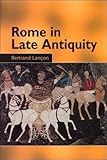Rome in Late Antiquity : Everyday Life and Urban Change, AD 312-609 / Bertrand Lançon.
Material type: TextPublisher: Edinburgh : Edinburgh University Press, [2022]Copyright date: ©2000Description: 1 online resource (186 p.) : 16 illustrations and 2 mapsContent type:
TextPublisher: Edinburgh : Edinburgh University Press, [2022]Copyright date: ©2000Description: 1 online resource (186 p.) : 16 illustrations and 2 mapsContent type: - 9780748612390
- 9781474469975
- 937
- DG311.L3613 2000
- online - DeGruyter
| Item type | Current library | Call number | URL | Status | Notes | Barcode | |
|---|---|---|---|---|---|---|---|
 eBook
eBook
|
Biblioteca "Angelicum" Pont. Univ. S.Tommaso d'Aquino Nuvola online | online - DeGruyter (Browse shelf(Opens below)) | Online access | Not for loan (Accesso limitato) | Accesso per gli utenti autorizzati / Access for authorized users | (dgr)9781474469975 |
Browsing Biblioteca "Angelicum" Pont. Univ. S.Tommaso d'Aquino shelves, Shelving location: Nuvola online Close shelf browser (Hides shelf browser)

|

|

|

|

|

|

|
||
| online - DeGruyter Envy, Spite and Jealousy : The Rivalrous Emotions in Ancient Greece / | online - DeGruyter Religion : The Modern Theories / | online - DeGruyter Theories of Religion : A Reader / | online - DeGruyter Rome in Late Antiquity : Everyday Life and Urban Change, AD 312-609 / | online - DeGruyter Women's Periodicals and Print Culture in Britain, 1940s-2000s : The Postwar and Contemporary Period / | online - DeGruyter Modernist Disguise : Masquerade in Modern Performance and Visual Culture / | online - DeGruyter Film Genre : Hollywood and Beyond / |
Frontmatter -- Contents -- List of maps -- List of illustrations -- Abbreviations -- Preface -- Foreword to the English translation -- Introduction: The city between antiquity and the Middle Ages Mark Humphries -- Contributor -- I. Maiestas Quirini: The majesty of the Quirinal -- 1. Looking at the city -- 2. Transforming the city's image -- 3. The phoenix city: War and ivasion in the fifth and sixth centuries -- 4. Urban administration -- II. Plebs patresque: Plebeians and patricians -- 5. The nobility, elite of the human race' -- 6. Tradesmen and plebs -- III. Religio: Religion and religiosity -- 7. Ancestral cults -- 8. The expansion of Christianity -- IV. Saeculum: Worldly -- 9. Life and death: Material civilisation and mental attitudes -- 10. Transforming the calendar -- 11. Festivals and entertainments -- 12. Education and culture -- 13. The influence of Christian Rome -- Conclusion -- Notes -- Chronology -- Guide to further reading Mark Humphries -- Index
restricted access online access with authorization star
http://purl.org/coar/access_right/c_16ec
This is a history of life in ancient Rome from the third to the seventh centuries AD. At the beginning of the period Rome was the centre of civilisation, by far the greatest city in the world, whose vast revenues supplied its million people with lavish provisions of food and wine and at least one hundred days of spectacular entertainment each year. It was a city of pristine marble, brightly coloured stucco, with temple and government buildings roofed in dazzling gold and bronze. Its citizens had access to public baths, gardens, libraries, circuses, amphitheatres, and venues for sea-fight spectacles. Well-maintained roads and aqueducts stretched from it in all directions.When Pope Gregory died in Rome in 604 Rome had become a papal power, the centre of western Christianity, the Pantheon itself transformed into a church. The author examines the conversion first of the plebs and later of the nobility, the long struggle between ancient rituals of worship and Christianity, and charts the effects of the latter's triumph on the social and physical fabric of the city.Professor Lancon describes the building of the great city wall which in 410 failed to prevent the first of a series of violent Gothic and Vandal incursions, and the citizens' valiant and repeated efforts to restore their city's glory. He considers changes in sexuality, the position of women, education, the family and life cycle, in the measurement, of time, and in the calendar of games and festivals. He examines the continuing role and prestige of the Senate, and the early years and rise of the papacy.Bertrand Lancon brings three turbulent centuries of life in the world's greatest city vividly before the reader's eye: his account is as readable as it is scholarly. The book is introduced by Mark Humphries, who has also provided a guide to further reading for anglophone readers.
Mode of access: Internet via World Wide Web.
In English.
Description based on online resource; title from PDF title page (publisher's Web site, viewed 29. Jun 2022)


